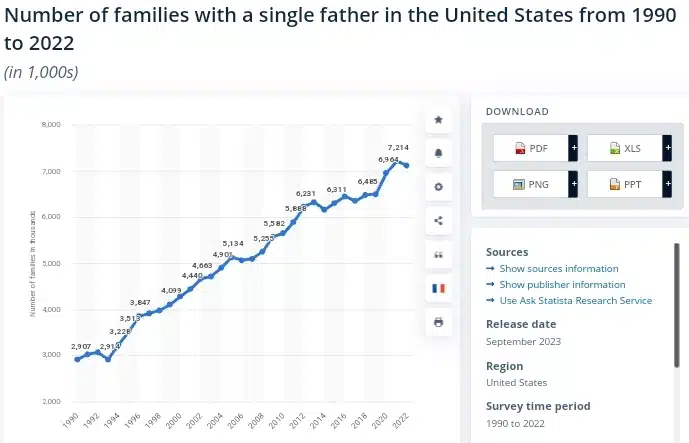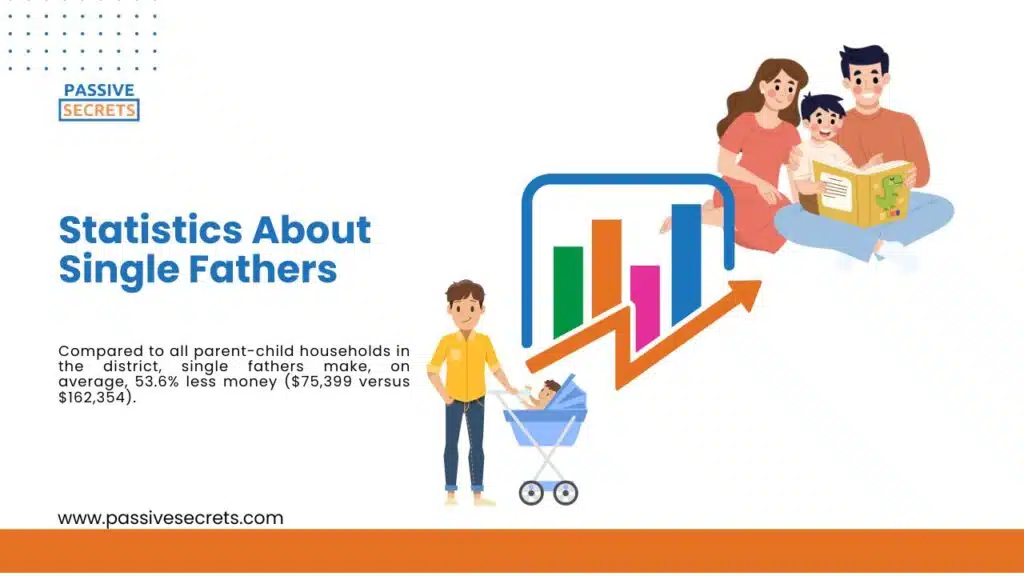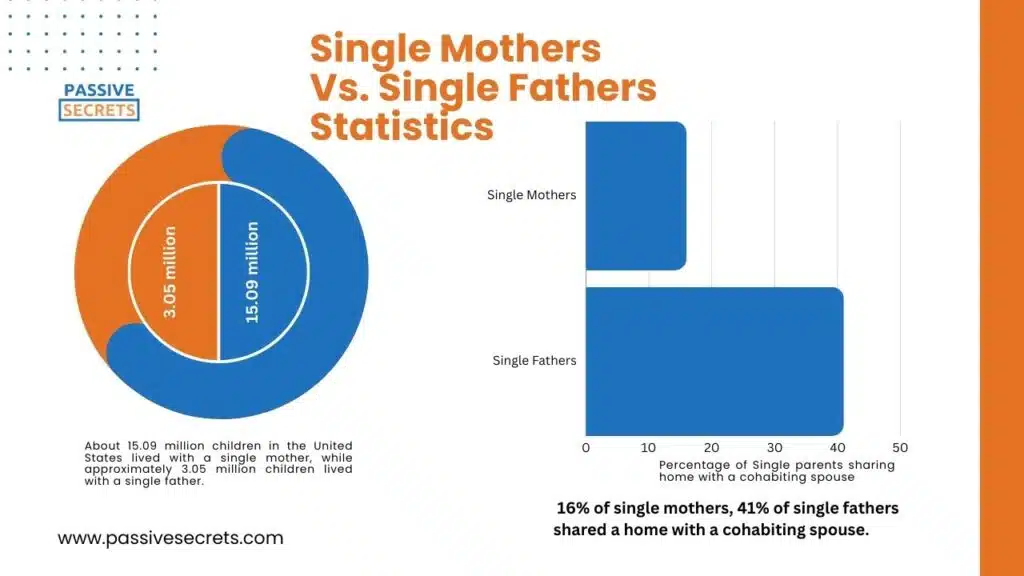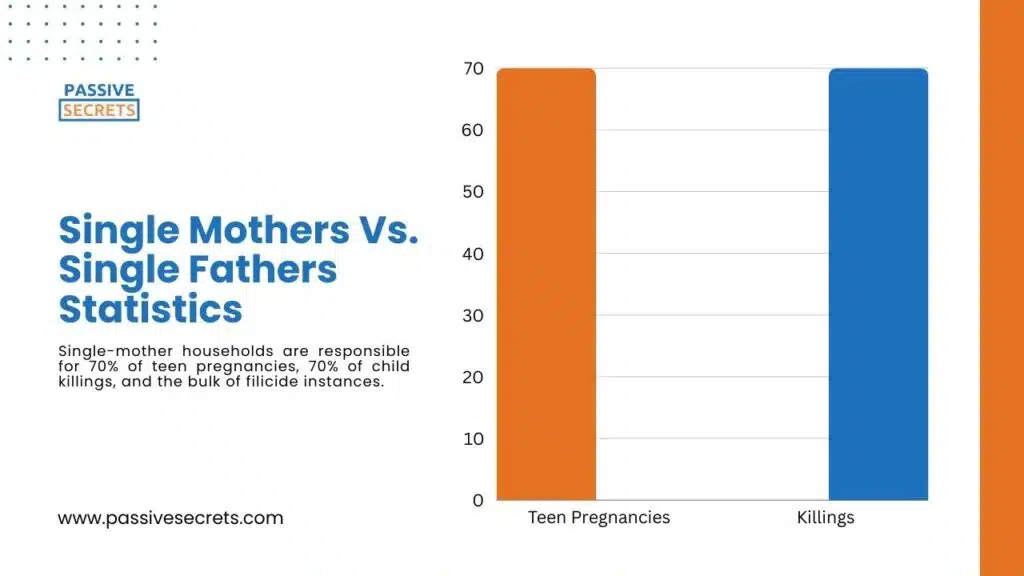
Did you know that the number of single fathers in the United States has been steadily rising over the past few decades?
According to recent statistics, there are over 3.3 million single fathers in the U.S., comprising about 20% of all single-parent households.
Even so, black single fathers are one of the most ignored demographics in the world.
This shift highlights a significant societal change, shedding light on the challenges and triumphs faced by single fathers taking on the role of both caregiver and provider.
Join us as we explore these amazing single father statistics that reveal the strengths and challenges of single fatherhood.
Key Single Father Statistics
- The United States had approximately 7.13 million families with a male householder and no spouse.
- Of single dads, about 26% have not finished high school, and 17% have some college experience.
- Roughly 46,000 children in the United States who lived with single fathers who were never married were receiving government support in 2021.
- Approximately 188,000 Black families with a single father lived in poverty in the United States.
- Nevada has the highest percentage of single fathers.
- Approximately 386,000 Asian households headed by a single father were residing in the US in 2021.
- About 15.09 million children in the United States lived with a single mother, while approximately 3.05 million children lived with a single father.
- Compared to other family heads, single fathers use health and behavioral health services for their children at a lower rate.
General Statistics About Single Fathers
1. In 2022, the United States had approximately 7.13 million families with a male householder and no spouse. (source)

2. About 3 million children under the age of 18 live with a single father. (source)
3. 2,251,000 households are headed by a single father. (source)
4. Of all single parents, 20% are fathers. (source)
5. There are about 1.21 million Black families headed by a single father in the US. (source)
Compared to 1990, when there were 472,000 Black households in the United States headed by a single father, this represents an increase.
6. About 2.6 million families in the USA, 330,000 in Canada, and 300,000 in the UK are led by single fathers. (source)
7. Of single dads, about 26% have not finished high school, and 17% have some college experience. (source)
8. 38.6% of fathers in single-father households were widowed, 41.8% were separated or divorced, 8.2% were single, and 11.3% were married. (source)
9. In comparison to single mothers, 25% of single males are not concerned about their ability to pay for home necessities in the coming year. (source)
10. Roughly 46,000 children in the United States who lived with single fathers who were never married were receiving government support in 2021. (source)
11. Nevada has the highest percentage of single fathers. (source)
6.8% of parent-child families in the Silver State are headed by a single father; the other two states with percentages higher than 6% are Montana and Oklahoma.
12. In the District of Columbia, single fathers lag behind other parent-child families in terms of income. (source)
Compared to all parent-child households in the district, single fathers make, on average, 53.6% less money ($75,399 versus $162,354).

13. According to a research study, single fathers are more likely than married fathers to employ positive parenting techniques. (source)
14. 6.5% of Asian families with a single father in the United States lived below the poverty level. (source)
15. In 2022, approximately 188,000 Black families with a single father lived in poverty in the United States. (source)
16. According to LawnStarter research, Naperville is the third-best city in the nation for single fathers to reside in. (source)
17. About 261,000 children in the United States living with single fathers who had never married received food stamps. Also, 26,000 children living with single widowed fathers received food stamps. (source)
18. At 1.4%, Washington D.C. has the lowest percentage of households headed by a single father. (source)
19. Alaska is the state with the largest proportion of single-parent households headed by fathers. (source)
20. Approximately 386,000 Asian households headed by a single father were residing in the US in 2021. (source)
Compared to 2002, when there were 223,000 Asian households in the United States headed by a single father.
21. There are about 1.9 million Hispanic families with a single father in the United States in 2022, a decrease from the year before. (source)
22. Single fathers are less educated, younger, and live at or below the poverty level than married fathers (24% vs 8%). (source)
23. Compared to other family heads, single fathers use health and behavioral health services for their children at a lower rate. (source)
Single Mothers Vs. Single Fathers Statistics
24. About 15.09 million children in the United States lived with a single mother, while approximately 3.05 million children lived with a single father. (source)

25. Single fathers tend to be white, older, and more educated than single mothers. (source)
26. Compared to 16% of single mothers, 41% of single fathers shared a home with a cohabiting spouse. (source)
27. In 2023, the Netherlands had 492,300 single mothers. This is significantly higher than the number of single fathers in the Netherlands, which stood at 118,300 that same year. (source)
28. Compared to single mothers, single fathers are less likely to live in poverty and more likely to be divorced. (source)
29. Single-father families are often in a better financial position than single-mother families. (source)
30. Single fathers had a greater median age than single mothers, at 38.56 years against 36.44 years. (source)
31. Children in single-father homes perform similarly to children in single-mother families on many outcomes. (source)
32. Compared to single fathers, single mothers are more likely to experience mental health issues. (source)
33. Children from single-mother households are 9x more likely to drop out of high school and 10x more likely to use drugs than children from single-father households. (source)
34. On average, single fathers find it less difficult to discover positive female influences than single mothers do. (source)
35. Children from single-mother households are 5 times as likely to commit suicide than children from unbroken and single-father households combined. (source)
36. Single-mother households are responsible for 70% of teen pregnancies, 70% of child killings, and the bulk of filicide instances. (source)

Challenges Faced By Single Fathers
37. Single Fathers who identify as African American or Latino do not fare as well financially. (source)
38. Compared to their White counterparts, single fathers who identify as Latino or Black Americans are more likely to be homeless and unemployed because of systemic racism. (source)
39. Single fathers requesting social benefits reported receiving substandard customer service and having to navigate more bureaucratic hurdles than their female colleagues. (source)
40. Single fathers often face challenges about who should be the primary caregiver or not being believed when they state that the mother is not involved with the children. (source)
41. Because of their pride and the gendered role of being the only provider, many single fathers turn to unofficial social networks rather than the government for assistance. (source)
42. Single fathers and their children, who are more likely to be persons of color, are more vulnerable to the harmful and long-term consequences of the COVID-19 epidemic. (source)
42. When someone in a single father’s household becomes unwell, the difficulties of accessing health care and limited childcare options are increased. (source)
Impact Of Single Father Parenting On A Child
43. Compared to kids from other family types, children of single fathers exhibit greater rates of externalizing behaviors (such as delinquency and antisocial conduct) and substance abuse. (source)
Conclusion
These single-father statistics reveal a significant increase in single-father households and show the challenges and successes these fathers face daily.
Although they are often unrecognized, single fathers play a significant role in today’s society, with a growing number of households headed by single dads.
These fathers face unique challenges and obstacles, from balancing work and parenting responsibilities to dealing with societal stigma and stereotypes.
If you are a single father, know that you are not alone.
FAQs
1. What percentage of fathers are single?
Over 1.5 million single fathers head 4.6% of families where parents live with their children.
2. How does being raised by a single father affect a child?
Children raised by single fathers may face unique challenges, such as developing poorer relationships and communication skills. However, they can also develop positive traits like increased responsibility, maturity, and emotional regulation from helping with household duties.
3. What are the struggles of a single dad?
Single dads face various challenges, including balancing work and parenting, societal perceptions, financial pressures, lack of support, and emotional stress.

Related Posts:
- Thought-Provoking Gender Inequality Statistics: 160+ Insights Across Regions
- 110+ Shocking Income Inequality Data You Need to Know
- 50 Interesting Sharing Economy Statistics You Need to Know
- 100+ Animation Statistics: The Ultimate Guide To The Industry’s Trends and Insights
- 80+ Franchise Statistics and Facts You Should Know In 2024
- The Future of Learning: 50+ Top EdTech Statistics For 2024
- The Web3 Statistics Report 2024: Trends, Insights, and Predictions
- Meme Statistics 2024: Facts, Trends, and Figures That Will Blow Your Mind
- 85+ MOST Interesting Anime Statistics and Facts (NEW Report)
- Board Game Statistics: Revenue, Market Size, Demographics & More
- 125+ Interesting Airbnb Statistics by Country (Deep Insights)
- 50+ Interesting Born Into Poverty Stay In Poverty Statistics
- 90+ Interesting Film Industry Statistics (NEW Report)
- 80+ Alarming Technology Addiction Statistics You Must Know
- 65+ Impressive Chess Statistics and Facts To Know in 2024
- Spotify Statistics: Latest Report on The Music Streaming Platform
- 50+ Useful Video Game Addiction Statistics, Facts & Huge Trends
- 50+ Vital Internet Safety Statistics & Facts You Must Know
- Internet Dangers Statistics: A Look At The Internet’s Dark Side
- 50 Interesting Bible Statistics and Facts You Didn’t Know
- 95+ Interesting Dream Statistics and Facts You Can’t Miss
- 75+ Interesting Relationship Statistics & Facts You Should Know
- Dance Statistics: A Deep Dive Into The Rhythm Of Movement
- The Battle of the Sexes: Male Vs. Female Spending Statistics
- 95+ Jaw-Dropping Period Poverty Statistics You Need To Know
- 70 Exciting Love Statistics And Facts (True Love, Intimacy, Marriage, Dating & Relationships)
- 30+ Gentle Parenting Statistics & Facts: Is This Parenting Style Worth It?
- 55+ Useful Black Consumer Spending Statistics (2024 Report)
- Holiday Spending Statistics: Valentine’s Day, Easter, Thanksgiving, & Christmas

